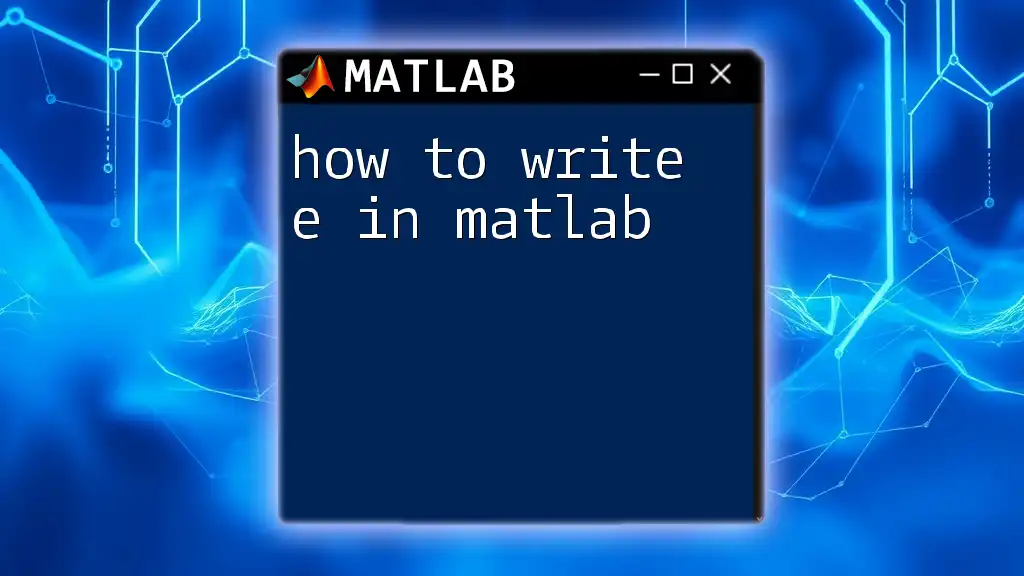The `ode45` function in MATLAB is used to solve ordinary differential equations (ODEs) using a numerical method and is particularly effective for non-stiff problems.
Here's a simple example to demonstrate its usage:
% Define the ODE as a function
odefun = @(t, y) -2 * t * y;
% Set the time span and initial condition
tspan = [0 5];
y0 = 1;
% Call ode45 to solve the ODE
[t, y] = ode45(odefun, tspan, y0);
% Plot the results
plot(t, y);
xlabel('Time t');
ylabel('Solution y');
title('Solution of ODE using ode45');
What is ode45?
The `ode45` function in MATLAB is a powerful numerical solver designed for solving Ordinary Differential Equations (ODEs). It employs the Runge-Kutta method, specifically a pair of 4th and 5th-order algorithms, which adaptively adjust their step size for accuracy. This feature makes `ode45` suitable for a wide range of ODE problems across various domains, including engineering, physics, and biology.

Getting Started with ode45
To begin using `ode45`, ensure your MATLAB environment is set up for solving ODEs. You can create a new script file where you will write your function and commands. The basic syntax for the `ode45` function is as follows:
sol = ode45(odefun, tspan, y0)
Here, `odefun` is your function representing the ODE, `tspan` defines the interval of integration, and `y0` is your initial condition.

Step-by-Step Guide to Using ode45
Defining the Differential Equation
The first step in utilizing `ode45` is to define the differential equation you want to solve. This is generally done by creating a separate function. For example, consider a simple first-order ODE:
\[ \frac{dy}{dt} = -2y + 2 \]
You can write this function in MATLAB like this:
function dydt = myOde(t, y)
dydt = -2 * y + 2; % Example ODE
end
Specifying Initial Conditions and Time Span
Next, you need to specify the time span for the solution and the initial condition. The time span is defined as a two-element vector, while the initial condition represents the value of \( y \) at \( t = 0 \). For instance:
tspan = [0 5]; % Time from 0 to 5 seconds
y0 = 1; % Initial condition
Using ode45 to Solve the ODE
Now that you've defined the ODE and initialization parameters, you can use `ode45` to solve the equation. Here’s how to execute the function:
[t, y] = ode45(@myOde, tspan, y0);
In this command, `@myOde` specifies the function you previously defined, while `t` and `y` will hold the output time points and the corresponding solution values, respectively.
Visualizing the Results
Visualization plays a crucial role in interpreting the solution to an ODE. You can easily plot the results using MATLAB's built-in plotting functions. Here's a simple way to visualize your results:
plot(t, y);
xlabel('Time (s)');
ylabel('Solution y(t)');
title('Solution of the ODE using ode45');
grid on;
This plot will provide a clear picture of how the solution \( y(t) \) evolves over time.

Advanced Features of ode45
Adaptive Step Size Control
One of the key advantages of using `ode45` is its adaptive step size control, which adjusts the step size according to the solution's behavior to ensure accurate results. Additionally, you can set tolerances to control the error in the solution. This can be done using the `odeset` function as follows:
options = odeset('RelTol',1e-6,'AbsTol',1e-8);
[t, y] = ode45(@myOde, tspan, y0, options);
In this example, `RelTol` and `AbsTol` control the relative and absolute tolerances respectively.
Using ODE Functions with Multiple Variables
For systems of ODEs, you can define a function that takes a vector as an input. For instance, a simple harmonic oscillator can be expressed as follows:
function dydt = mySystem(t, y)
dydt(1) = y(2);
dydt(2) = -k * y(1); % Assuming some spring constant k
end
When calling `ode45`, you would then treat `y` as a vector of variables.

Common Errors and Troubleshooting ode45
When using `ode45`, you may occasionally encounter errors or warnings. Common issues include:
- Dimension Mismatch: Ensure that your output dimensions from the ODE function match what `ode45` expects.
- Too Many Points: If you receive warnings about "Too many output points," it may indicate that the integration step size is too small to be efficient. You can adjust tolerances as mentioned earlier.
- Initial Conditions: Make sure your initial conditions are correctly defined, as incorrect values may lead to unexpected results.
Best practices include thoroughly testing the function, starting with simpler ODEs, and gradually increasing complexity. Always check your results by comparing against known solutions if possible.

Real-World Applications of ode45
The applications of `ode45` in MATLAB are vast. It’s frequently utilized in various fields for simulations, such as:
- Physics: For modeling motion, dynamics, and electromagnetism.
- Biology: In population dynamics or biochemical reactions where changes occur over time.
- Engineering: To analyze systems such as control systems or mechanical vibrations.
For instance, a case study might include modeling the motion of a pendulum or analyzing chemical kinetics in a reaction network.

Conclusion
In this comprehensive guide on how to use ode45 in MATLAB, you've learned how to define differential equations, set up initial conditions, implement the `ode45` solver, visualize solutions, and explore its advanced features. By practicing with various ODEs, you will gain a deeper understanding of not only `ode45` but also the fundamental principles governing differential equations. Embrace the learning process and leverage MATLAB's capabilities to solve complex ODE problems effectively.

Additional Resources
For further exploration, consider delving into the [MATLAB documentation](https://www.mathworks.com/help/matlab/ref/ode45.html) for `ode45` and other numerical solvers, as well as engaging with the MATLAB user community for valuable insights and support.

















